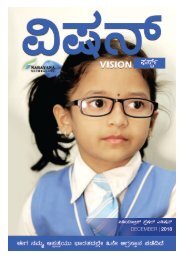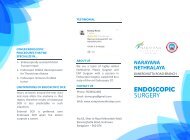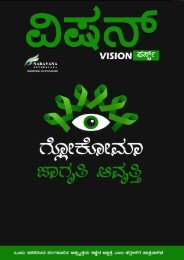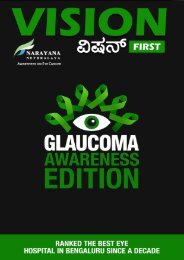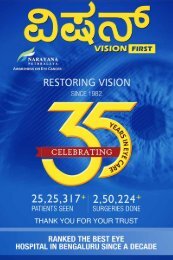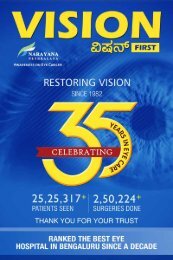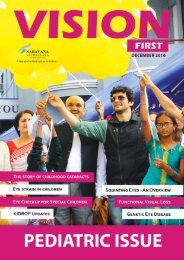Vision First July 2018 English
You also want an ePaper? Increase the reach of your titles
YUMPU automatically turns print PDFs into web optimized ePapers that Google loves.
Signs and symptoms of refractive errors<br />
Refractive<br />
errors<br />
The most common symptom of a refractive error is blurred vision. Patients report symptoms of eye strain and blurring, with difficulty<br />
in prolonged reading. Symptoms of double vision, haziness, glare or halos around bright lights, squinting and headaches may<br />
also occur.<br />
Children with refractive errors can be identified when they go close to a screen or squint to see clearly. Teachers play a vital role in<br />
picking up refractive errors in children as they can notice these problems in a classroom setting.<br />
Uncorrected refractive errors in children can cause lazy eye. One of the key ways to avoid vision loss in children is the early detection<br />
of refractive errors. This can be achieved if there is enough awareness about paediatric refractive errors amongst parents and<br />
caretakers. Regular eye check-up, evaluation for even minor degrees of squinting, and good compliance to patching therapy for the<br />
lazy eye can avoid vision loss amongst children and adolescents.<br />
Tests and Diagnosis<br />
A refractive error can be diagnosed during a routine eye examination when a patient visits an ophthalmologist with<br />
complaints of visual discomfort or blurred vision. The refractive error is diagnosed by asking the patient to read a<br />
vision chart, while the ophthalmologist tests an assortment of lenses to maximize the patient’s vision<br />
Treatment for Refractive Errors<br />
Refractive errors can be corrected with corrective lenses such as eye glasses or contact lenses (in adolescents and<br />
older people). These are prescribed during regular follow up visits to an ophthalmologist, who ensures a comprehensive<br />
evaluation. Laser eye surgery (LASIK) may also be used to correct some refractive disorders. Patients with<br />
corrected refractive errors have a better quality of vision, thus improving quality of life.<br />
In a normal eye, the cornea and lens are smooth and curved equally in all directions which allow light rays to focus sharply onto<br />
the retina, the light-sensitive surface at the back of the eye. This produces a clear image for the brain to process. An irregularly<br />
shaped cornea or lens prevents light from focusing properly on the retina, causing blurred or distorted vision. This is known as a<br />
refractive error.<br />
Refractive errors are caused due to changes in the length of the eyeball (longer or shorter), changes in the shape of the cornea, or<br />
age-related stiffness of the lens. The main types of refractive errors are myopia (near-sightedness), hyperopia (farsightedness),<br />
presbyopia (loss of near vision with age) and astigmatism.<br />
Myopia or nearsightedness is a refractive error where objects up close appear clearly, while objects far away appear blurry. In<br />
myopia, light from a distant object forms an image before it reaches the retina. This could be because of longer length of eye ball or<br />
cornea and lens being more curved.<br />
Hyperopia or long-sightedness is a refractive error where distant objects can be seen clearly, while objects that are near may<br />
be out of focus. In hypermetropia, light from a distant object forms an image behind the retina. This could be because of smaller<br />
length of eyeball or cornea and lens not refracting light enough.<br />
Presbyopia is a refractive error where the ability to focus up close becomes more difficult due to age-related changes in the<br />
eye. As the eye ages, the lens becomes stiff and cannot change its shape enough to allow the eye to focus on close objects clearly.<br />
Astigmatism is a type of refractive error in which the eye does not focus light evenly onto the retina, which can cause images<br />
to appear blurry and stretched out. This could be because people with astigmatism have corneas that are oblong (imperfection in<br />
the curvature of the cornea) or lens that are irregular in shape, which distorts light as it enters the eyes. Astigmatism frequently<br />
co-exists with other vision conditions like myopia and hyperopia which results in distorted or blurred vision at all distances.<br />
Anisometropia is a condition where both the eyes have significantly unequal refractive power.<br />
Who is at risk for refractive errors?<br />
Refractive errors are very common and are one of the leading causes of visual impairment in children. While presbyopia affects<br />
most adults over the age of 40, other refractive errors can affect both children and adults. If your parents have certain refractive<br />
errors, you may be more likely to be affected with one or more refractive error.<br />
Often undiagnosed with an equal prevalence in rural and urban areas, refractive errors, when left uncorrected, can lead to irreversible<br />
decrease in vision in one eye or both eyes depending on the severity, especially in children.<br />
8 Narayana Nethralaya | Ranked Among The Top 10 Eye Hospitals in India Since A Decade www.narayananethralaya.org Narayana Nethralaya | Ranked Among The Top 10 Eye Hospitals in India Since A Decade www.narayananethralaya.org 9




